AMD Radeon HD 7790 Review Feat. Sapphire: The First Desktop Sea Islands
by Ryan Smith on March 22, 2013 12:01 AM EST- Posted in
- GPUs
- AMD
- Sapphire
- GCN
- Radeon HD 7000
Power, Temperature, & Noise
Last but not least of course is our look at power, temperature, and noise. AMD designed the Bonaire GPU in the same vein as Cape Verde, making it slightly bigger and slightly more power hungry, but not immensely so. As a result of this and other considerations the 7790’s typical board power is rated at 85W, just 5W over the 7770’s. Now we’ll see how that translates to real world conditions.
Stopping quickly to take a look at voltages, while AMD’s clock averaging algorithm means that we cannot see the individual states, we can still see the idle and top states just as before due to the fact that these are easily sustained states. So we know what kind of voltage our 7790 reference card is pulling at idle and at 1GHz. To that end we’re seeing a idle voltage of 0.894v and a load voltage of 1.263v according to GPU-Z.
| Radeon HD 7790 Voltages | ||||
| Ref 7790 Idle | Ref 7790 Load | Sapphire 7790 Load | ||
| 0.894v | 1.263v | 1.263v | ||
For anyone curious about the impact of the latest rendition of PowerTune, we also recorded the average (average) clockspeed of the 7790 in all of our games. Since PowerTune in this case is being used purely as a throttling mechanism and not as a boost mechanism, there’s actually very little to report here. Our 7790 sustained 1GHz in each and every game. Even in FurMark the average clockspeed was only slightly reduced, to 975MHz. Given what we’re seeing, we don’t see any reason that any other 7790 card shoudn’t be doing the full 1GHz the vast majority of the time.
| Radeon HD 7790 Average Clockspeeds | |||
| Base Clockspeed | 1000MHz | ||
| DiRT:S | 1000MHz | ||
| Shogun 2 | 1000MHz | ||
| Hitman | 1000MHz | ||
| Sleeping Dogs | 1000MHz | ||
| Crysis | 1000MHz | ||
| Far Cry 3 | 1000MHz | ||
| Battlefield 3 | 1000MHz | ||
| Civilization V | 1000MHz | ||
| FurMark | 975MHz | ||
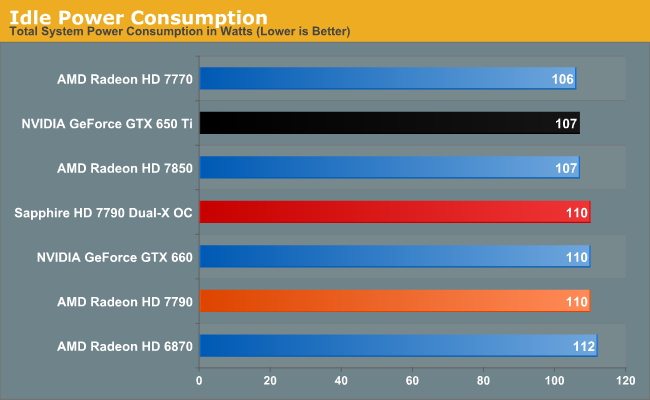
Kicking things off as always is our look at power consumption. We are measuring power consumption at the wall for the entire system, so these numbers are almost entirely composed of everything but the video card, but it still is sensitive enough to identify any cards that may be significantly worse than today’s low-idling cards.
For reasons we’re not entirely sure of, we’re seeing 7790’s idle power consumption come in at just a bit higher than both the 7770 and 7850. As Bonaire is a larger GPU the former isn’t unusual, but it’s not clear why 7790 is pulling more power at idle than the larger yet 7850 and its 2GB of GDDR5. The difference at the wall is only a couple of watts, but it is repeatable.

Looking at our first load power test with Battlefield 3, we can see that our test results are very close to AMD’s typical board power rating. Both the reference and Sapphire 7790 cards are pulling 7W more than the 7770, a hair more than the 5W difference in AMD’s TBP. Considering the fact that the 7790 is nearly 30% faster than the 7770 on average, this is quite an accomplishment on a power/performance basis for AMD in the span of a year. It’s a very reasonable increase in performance for very little of an increase in power consumption. This also means that the 7790 looks good against the 7850; the 7850 is faster, but it draws 22W more at the wall.
But perhaps more interesting is the 7790 against the GTX 650 Ti. The 650 Ti is around 5% faster in this test, but it’s also leading to our testbed drawing 12W more at the wall. As BF3 is a game test, power consumption does scale slightly with performance due to the extra work put on the CPU to generate the additional frames, but a 5% performance difference in this case would not explain a 12W increase in power consumption. NVIDIA has for a long time set the bar on efficiency, but with the 7790 it looks like AMD will finally edge out NVIDIA.
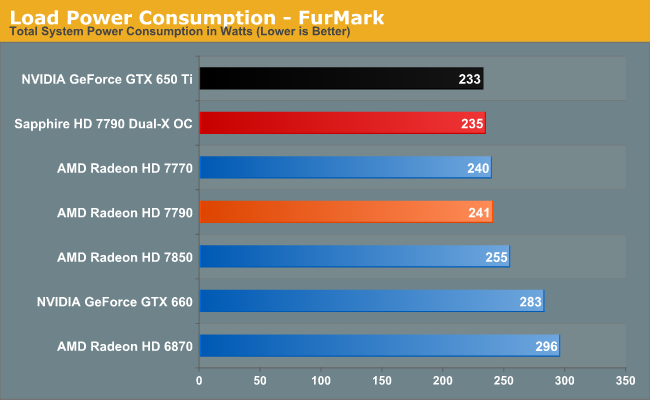
Moving on to FurMark the picture changes a bit. Against the 7770 the 7790 once again looks great, with the difference at the wall being a single watt, while drawing 14W less than the 7850. On the other hand the 7790 is now drawing slightly more than the GTX 650 Ti, but as we’ve see before game tests and FurMark can sometimes be at odd since FurMark is an explicit test of a card’s power throttling systems. NVIDIA looks to be throttling a bit harder than AMD, which would lead to what we’re seeing.
At the same time our 7790 cards show a bit of variance. The Sapphire card, despite being overclocked, draws 6W less than our reference 7790. There are some temperature differences between the cards due to their different coolers, so with the new PowerTune this may be a manifestation of the impact of power. Or it could just be standard variation for 7790, taking into consideration that the GPU in the Sapphire card would be binned. In FurMark this is mostly an intellectual curiosity. Once we have more 7790s we may be able to break it down further.
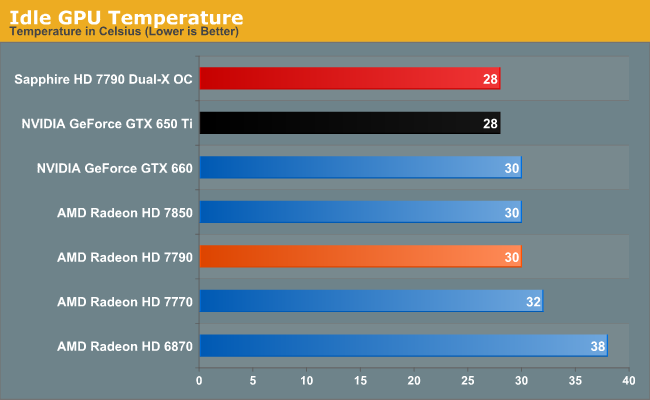
Looking at idle temperatures there are no great surprises here. Sapphire’s Dual-X cooler can bring their card down to 28C, while our reference card hits 30C. Idle temperatures on these low-wattage GPUs aren’t too far above room temperature.
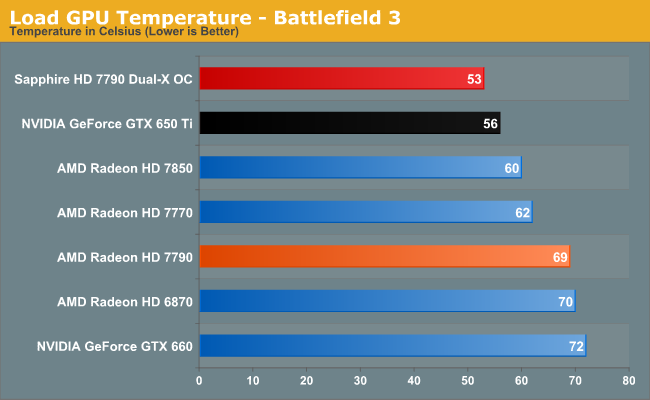
Jumping to load temperatures, the reference 7790 with its admittedly average cooler is particularly average in the temperature department. 69C is warmer than the 7850, 7770, and the GTX 650 Ti, but as it’s still under 70C these are by all considerations still cool temperatures. Sapphire’s cooler in the meantime looks very good here. 53C when running BF3 is quite an accomplishment, especially since our reference GTX 650 Ti does so well in this test.
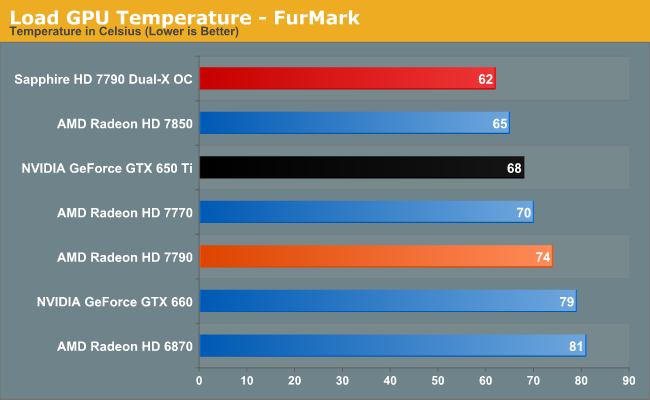
Cranking things up to the max for FurMark, we can see that temperatures are up across the board. The reference 7790 is now at 74C, which is warm but not exceptional. It’s still a low enough power card that even a half-decent cooler is enough to render temperatures meaningless. Meanwhile Sapphire’s card once again takes top honors at a relatively chilly 62C, 3C cooler than the otherwise overbuilt 7850, and 6C cooler than the reference GTX 650 Ti.
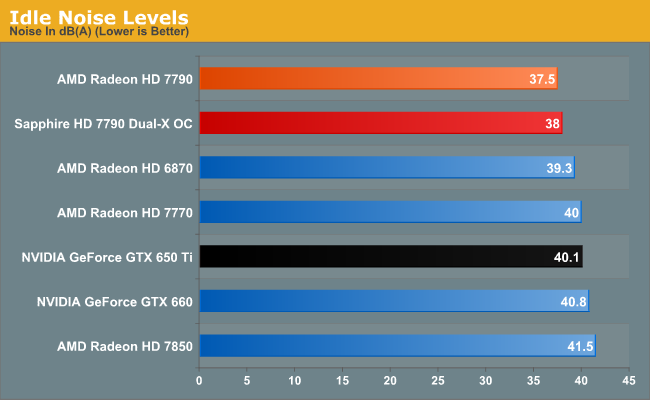
Both of our 7790 cards look good when it comes to idle noise. The reference 7790 with its one fan runs up against the noise floor at 37.5 dB(A), while the Sapphire card with its two fans is just a bit louder at 38 dB(A). In lieu of passive cooling this looks like a decent option for silent PC enthusiasts looking for a quiet idle, though really anything at the GTX 650 Ti level or lower is doing rather well here.
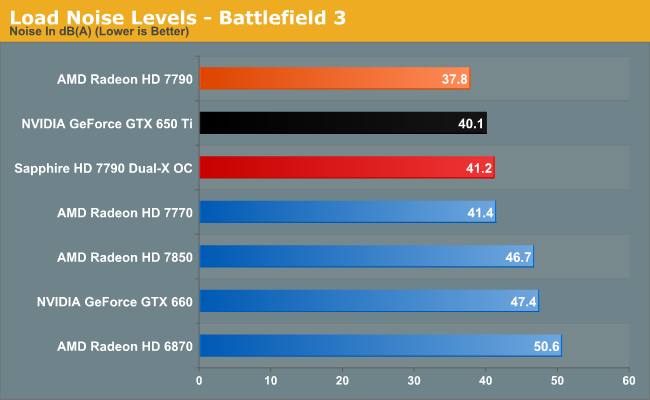
Jumping into load noise, we can see that the reference 7790 and its simple open air cooler thrives with our BF3 testing. Despite the jump in heat dissipation the amount of noise generated by its one fan has jumped by less than 1 dB(A), an almost imperceptible increase. At the same time this paints a picture of the reference 7790 where it looks like it has been optimized for noise over temperature, giving us reasonably acceptable temperatures for fantastic acoustics.
Sapphire’s card on the other hand isn’t set to favor acoustics over temperature, so those great temperatures we saw earlier do come at the expense of some noise. 41.2 dB(A) leaves it effectively tied with the 7770 and quite a bit quieter than the 7850, but over 3 dB(A) louder than the reference 7790, and 2 dB(A) louder than the GTX 650 Ti. If you’re looking for near-absolute silence here there is a clear benefit to the reference 7790 over Sapphire’s card, but 41.2 dB(A) is nothing to sneeze at.
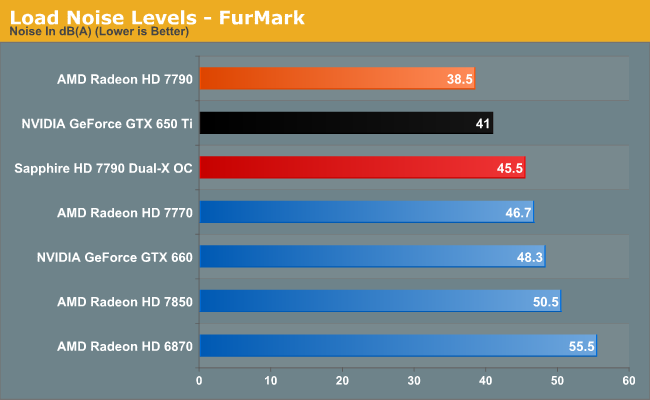
Finally we have our look at noise under FurMark. Again the reference 7790 does very well here, coming in at 38.5 dB(A), amazingly quiet for a >75W card under FurMark. This is over 8 dB(A) quieter than the 7770, 12 dB(A) quieter than the 7850, and over 2 dB(A) quieter than the GTX 650 Ti. AMD is more interested in pushing partner cards than their own design, but right now right here the reference design is looking very good.
As for Sapphire’s card, once more we see it favoring temperatures over noise. 45.5 dB(A) is still quieter than the reference 7770, so Sapphire isn’t doing badly here. But the reference 7790 and even the GTX 650 Ti back it into a corner. If you care about noise than the reference 7790 is a better configuration, but if you care about temperature the Sapphire is going to be a tough act to beat.
It goes without saying of course that these noise improvements come despite a 30%+ increase in performance over the 7770, and contrast against a marginal increase in power consumption. The price difference between the 7770 and 7790 put them in distinctly different categories, but the 7790s we’re seeing are clear improvements over the 7770 in practically every way. These gains aren’t quite as remarkable when placed against the GTX 650 Ti due to the latter’s high efficiency out of the gate, however that doesn’t mean AMD hasn’t managed to surpass NVIDIA here. BF3 power consumption and noise testing on our reference 7790 tells us that AMD can edge out NVIDIA in the efficiency department here, especially since this comes with a 10% performance improvement.










107 Comments
View All Comments
Sabresiberian - Monday, March 25, 2013 - link
A roadmap is nothing but a projection of what is PLANNED for the future, not some kind of "promise" or "guarantee". Calling AMD people liars because the released product didn't match the projection is childish at best.And before you slap the "fanboy" label on me, I prefer Nvidia generally speaking (but I'm not going to cut off my proverbial nose to spite my face in order to be brand loyal; if AMD has the current best solution for my purposes, I'm going to buy AMD).
CeriseCogburn - Saturday, March 23, 2013 - link
128 bit bus is great, the HD5770 proved that.BWHAHAHHAAA
dishayu - Friday, March 22, 2013 - link
Good eye. But then they metion HD7790 as Pitcairn LE in that infographic. What they have launched as HD7790 now is Bonaire.ShieTar - Friday, March 22, 2013 - link
Maybe they surprised themselves by getting GDDR5 to run at 6GHz, and realized that they can stick with 128bit at that speed?Lonyo - Friday, March 22, 2013 - link
They were going to use a cutdown Pitcairn, being 7870/7850 GPU, and cut down the GPU core to use excess cores that couldn't make the cut as 7870/7850s.They might have gone with 256-bit to simplify the product for AIB partners who could just re-use their HD7850 designs, rather than needing a new design for a smaller run product.
The 7790 now is a new GPU designed to be cheaper to produce (as it's smaller) than Pitcairn, and the fact the memory can run at 6GHz is probably due in part to the fact it's a new GPU rather than a cut down Pitcairn.
CeriseCogburn - Friday, March 22, 2013 - link
I don't see a launch date in the whole article, it's NOT available. I guess that's another mystery freebie for AMD's products here.Didn't see port config either, so what cabling do we have to buy to run 3 monitors when Asus 650ti runs 4 out of the box, 3 with dvi and vga only ?
Not impressed with the huge AMD biased game line up either, so expect your mileage to be less than shown.
No overclock talk really either - so it must blow at that.
Other sites are reporting amd's beta driver, so maybe they won't even have a release driver for this card when they release it, as AMD is often known to do, for like a year sometimes or forever in terms of any sort of quality-LOL.
Civ5 has only 1 bench rez, it must have crashed in others.
Crossfire ? Article didn't say.
Multi-monitor - no talk of that anymore since nVidia SPANKS amd to death on that now.
Hopefully you've fooled the internet tards again, because amd is bankrupt, for good reason.
Spoelie - Friday, March 22, 2013 - link
Let's feed the troll.Did you even read the article?
-Launch date is mentioned on page 1, in one and a half week
-Ports are clearly visible and standard, 2 DVI + HDMI + DisplayPort
-Lineup is consistent with every other review on Anandtech.
-There's an entire page on the new PowerTune and how it impacts overclocking, single sample OC investigation is irrelevant and best left for a dedicated vendor comparison.
-... really?
Who's the real tard here?
Spunjji - Friday, March 22, 2013 - link
Oh for a down-vote button. We expect no less than mindless bollocks from Cerise, but failing to read the article entirely is a new low.CeriseCogburn - Saturday, March 23, 2013 - link
No, that's what you do all the time. But thanks for the compliment, since you know I always read the articles completely, yet you think I didn't this time, WRONG.I've made a lot of money this past short week without a lot of rest, so I'll give you and dipsy doodle a point on the svengali launch date the article writer for the first time EVER declares "solid" before it even occurs, og wait, he always does that when it's AMD, but if it's nVidia he says we'll have to wait and see as they are probably lying...
ROFL
Who cares, the card sucks, amd is dying, the drivers blow beta chunks, and amd is way late to the party.
ppeterka - Thursday, July 18, 2013 - link
Just a question: And how much will your favored brand of GPUs cost, if AMD really dies? 10 times? 100 times? An arm, a leg, and both kidneys? Grow up, and understand how an ecosystem works for us all.BTW. I don't have GPU preferences, just grab what gives bets bang for bucks. If it has EasternElbonianVideoPigs GPU on it - be it...